Postal Cards vs. Postcards: Although it has not always been the case, the term Postal Card today is usually used to refer to a pre-stamped card issued by the government with room for an address on the stamp side and room for a message on the other side. With postal cards the stamp side is usually the side of most interest and is called the front of the card.
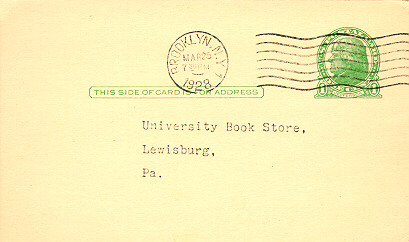
Post cards or Postcards, on the other hand are not pre-stamped. One side usually contains some sort of image. Since this is the side of interest to most postcard collectors, it is usually called the front or face of the card. The other side is referred to as the back or the address side.
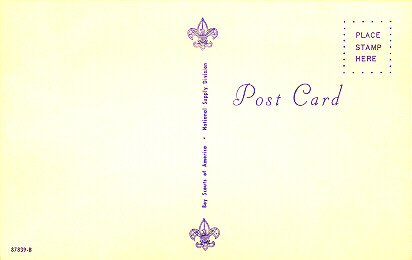
Since late in 1907, the address side is usually divided down the middle by a spine, which could be almost anything from a decorative line to a line of text with the publishers name. Messages may be placed to the left of the spine: only an address may be placed on the right. In the upper right corner a stamp box usually indicates where a stamp should be affixed. The word or words "Post Card" usually appear somewhere near the top of the address side. It was extremely rare for different printers to use the same design features: spine, stamp box, and font for "Post Card". Experienced collectors quickly learn to distinguish one edition of the "same" card from another by the design of the back and the color of the ink.
TopMaking Postcards
The image for the front of a postcard could start with a photograph or with original art work. If based on a photograph, the image could be transferred to a wide variety of paper stock via a printing process. Alternatively it could be made directly from a photographic negative into an actual print on photographic paper by a developing process. Only if made by the latter process, is a postcard referred to as a real photo or photographic postcard. If produced in small or medium quantities for sale, real photos are called published real photos.
Printed postcards may be distinguished (and approximately dated) by the printing process. Before World War I, high quality multi-colored postcards were almost always imported and are marked with their country of origin: the best were from Germany. Characteristically, these chromolithographed cards, or chromos, are full bleed, meaning that there is no border and the image goes off the edge of the card.
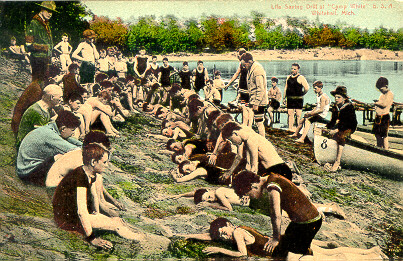
The importation of postcards became prohibitively expensive after the war and publishers turned to U.S. printers who used cheaper card stock and inferior reproduction processes.
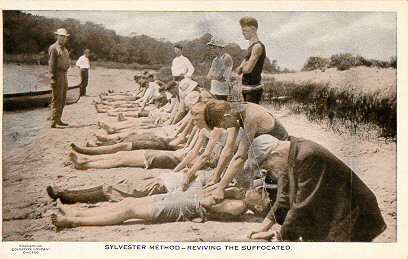
Almost invariably these cards, whether printed in color or in black and white had borders around the picture, and the period of time from the mid-teens until the mid-thirties is often known as the white border era. Typically, many postcards are printed on one sheet and cut apart. When there are borders the cutting does not have to be as precise as when there are no borders. By the latter part of the white border period the colors had become quite vivid.
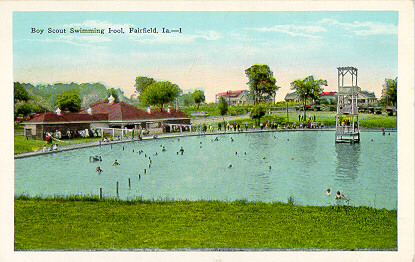
By the mid twenties, some printers discovered a textured paper that held color very well. It gave a woven appearance to the postcards, and as a result they are commonly known as linens. The linen era lasted for thirty years by which time some printers were producing full bleed linens.
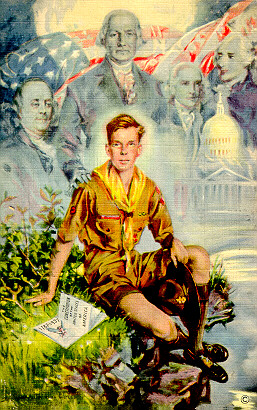
The 1937 Jamboree card by Christy, is a wonderful example of an artist-signed work reproduced as a full bleed linen card.
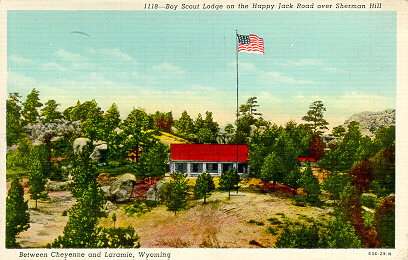
Although begun earlier, the printing process that came to dominate the postcard industry in the 1950s resulted in a glossy full-color full-bleed image that looks almost like a photograph. These cards are known as chromes. The name was taken from the Kodachrome film that first made them possible. Chrome cards are easily recognized. They remain the most popular among tourists to this day.
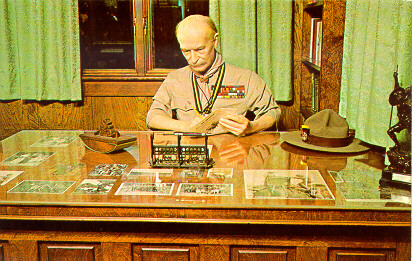
The standard size for postcards has been 3 3/8 x 5 3/8 inches either horizontal or vertical. There is some slight variation, but any card that deviates by much more than a quarter of an inch is immediately noticeable and considered non-standard. Starting in the 1960s some publishers began to take advantage of lower overseas printing prices. Initially much of the printing was done in Italy where printers were used to a European size of approximately 4 x 6 inches. These cards are known as continentals, which today refers to the size and not the place of origin. Currently most of the continentals are printed in China.
In addition to standard and continental, postcards exist in a variety of other sizes. Miniature cards appear in white border, linen, chrome, and real photo formats. The miniature Boy Scout postcards that the author has seen were all issued by camps. Dexter Press, the major publisher of chrome cards, produced some of their cards as Giant Postcards with a 6 x 9 inch format. Bi-folds and tri-folds are cards that have double or triple the standard size width and are designed to be mailed when folded to standard size. The author has one four-fold panoramic card of Kanowahke Lakes.
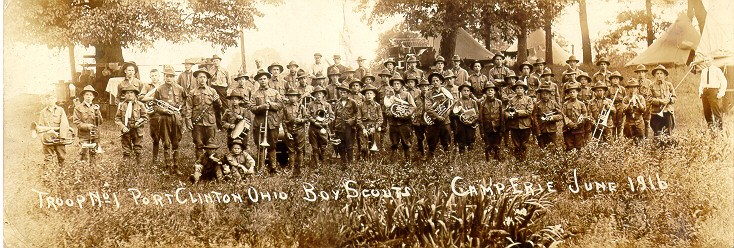
Novelty cards include postcards made out of non-standard materials, such as leather, aluminum, copper, wood, or birch bark. Embroidered cards and woven cards also fall into this category. All cards that have foreign materials pasted on, such as hair, feathers, metal insignia, string, small booklets, and even photos, are considered to be novelty items. The B.S.A. produced a set of square postcards that contains recordings and can be played on a record player. These too are novelty cards as are postcards attached to calendars and note pads. So are installment sets, which were sold as individual cards but which, when placed together, form one picture.
TopThe Names on Postcards
Several people may have been involved in the production of a postcard, and some of their names or identifying marks may appear either on the front or the back. These include:
The creator of the image, either
The artist who drew the image - in which case the card is classified as artist-signed, or
The photographer who took the original photo.
An author who may have written some text reproduced on the card.
A publisher who put up the money and took the financial risks.
The printer responsible for the production work.
The vendor who actually sold the cards, often a store.
The copyright holder.
Any or all of these may be present, and for that matter, one individual could play several roles. Stores often commissioned cards and thus acted as publishers and vendors. Printers and photographers often acted as publishers. There is absolutely no consistency. When the Boy Scouts of America published cards, they often asked the printers to omit any identification.
TopThe Condition of Postcards
The following post card grades appear in Barr's Post Card News and are widely used by postcard dealers and collectors.
- Mint
- A perfect card just as it comes from the printing press. No marks, bends or creases. No writings or postmarks. A clean and fresh card. Seldom seen.
- Near Mint
- Like mint, but very light aging or very slight discoloration from being in an album for many years. Not as fresh looking.
- Excellent
- Like mint in appearance with no bends or creases, nor rounded or blunt corners. May be postally used or unused and with writing and postmark only on address side. A clean, fresh, card on picture side.
- Very Good
- Corners may be just a bit blunt or rounded. Almost undetectable crease or bend that does not detract from overall appearance of picture side. May be writing or postally used on address side. A very collectible card.
- Good
- Corners may be noticeably blunt or rounded with noticeably slight bends or creases. May be postally used or writing on address side.
- Average
- Creases and bends more pronounced. May be writing in margins on picture side. Postmark may show through from address side but not on main portion of picture. Corners more rounded.
- Poor
- Card is intact. Excess soil, stained, cancel may affect picture with writing on either side. Could be a scarce card hard to find in any condition with heavy creases.
- Space Filler
- Poor condition as above and may have corners torn or corners missing, etc. and breaks. Least desirable of all of the above.
Notice that the individual who describes a card as "upper left corner bent, right margin soiled, otherwise mint," is describing at best an "average" card.
TopPricing Postcards
Several important factors affect the ultimate price of a postcard. The first is the location where it is found and the knowledge (or lack thereof) of the seller. Old postcards generally move from private individuals through garage sales, estate sales and auctions to flea market dealers and antique dealers who sell them to postcard dealers who sell them at postcard shows. At each step of the way the price increases. When purchased from a Scout memorabilia dealer, or a private collector who has sifted through hundreds of Scout cards and selected only the best, the price will probably be even higher. Occasionally individuals misprice cards due to a lack of knowledge. Collectors must often decide whether to overpay or walk away.
The second important factor that affects the price of postcards is, of course, supply and demand. Chrome cards are relatively plentiful. Early cards are difficult to find, and it follows that they sell at higher prices then chromes. The majority of postcard collectors prefer standard size cards. Very few want continental, giant, miniature, or even multi-fold cards because non-standard sizes are difficult to store and display. Most postcard dealers respond by concentrating on standard size cards, and when they do have others, they tend to price them low to move them quickly. Scout cards that show people are more desirable than those that just show buildings or mountains. Scout cards that show Indians, or trains, or famous people appeal to a wider range of collectors. All of these considerations affect the price of cards.
The most important factor in the price of a card is condition. Chrome cards are sufficiently common, for example, that in anything less than "excellent" condition they have little or no value. Many dealers routinely throw them in their "quarter boxes" to get rid of them. Even older cards are affected dramatically by their condition. A drop in two grades almost always cuts the price in half.
All of the older cards are difficult to find. No dealers can "stock" them. The Scout Law cards are generally priced in the $15 to $20 dollar range. (All prices are for cards in very good to excellent condition as defined above.) Dealers usually want $25 to $35 for the Ryte-Me Calendar cards. A few years ago the Scout Gum cards started appearing at $30 to $35 apiece. These are so hard to come by that some dealers have begun asking the same price for cards in only "good" condition. The various activity cards generally sell for around $20, however, not all dealers recognize them, and they are really not very attractive, so it is occasionally possible to find one at half that price. The Commercial Colortype Cards seem to be a little more plentiful and can be found in the $8 to $12 range. The Gartner and Bender cards, the Boy Scout and the Campfire Girl, and the Boy Scout Christmas Cards are all usually priced in the $17 to $25 range. Signed Spurgin cards by Inter-Art usually run around $10 to $15 when they can be found. The Boy Scout Series by Valentine & Sons. sell in the $8 to $12 range. The complete Ryte-Me Calendar and the Note Pad are auction items and are rarely seen on the open market. Older camp and local postcards are usually priced between $3 and $15, with the lower prices available from dealers well outside the geographical location of the camp. Older chromes can be had from $1 to $6. The "Scouts of the World" chromes from the two boxed sets are generally priced from $1 to $3. However, in any kind of quantity the prices drop to around .35 per card. Whole boxes can still be found in the $30 to $50 range. Most people do not distinguish between the two sets.
Readers should be aware that the introduction of internet sales about a year ago has completely destabilized the postcard market. Here are two examples. The signed Christy linen from the 1937 Jamboree was usually offered in the $40 to $45 range at post card shows. A card sold in that price range in an on-line auction about August, 1998. Before it had closed two identical cards were offered. The price was about the same. Since that time, a new copy seems to be offered about every two weeks and the price has dropped steadily until they now sell in the $15 to $20 range. Occasionally copies accompanied by poor scans sell for less. Recently, an identified real photo with FIVE HOLES poked through it sold for $15. A month ago most dealers would have been embarrassed to ask a single dollar for the card and some would have thrown it away. There is no question that the internet, by providing a global marketplace, is affecting the supply and demand of postcards.